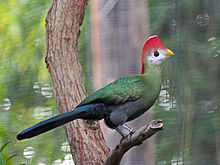Paraves
clade of all dinosaurs which are more closely related to birds than to oviraptorosaurs
Paraves is a branch-based clade containing birds (clade Aves) and other closely related dinosaurs. The paravians include the Avialae, such as Archaeopteryx, and the Deinonychosauria, which includes the dromaeosaurids and troodontids.
| Paraves Temporal range: Upper Jurassic–Recent
| |
|---|---|

| |
| Red-crested Turaco | |
| Scientific classification | |
| Kingdom: | |
| Phylum: | |
| Class: | |
| Superorder: | |
| Order: | |
| Suborder: | |
| (unranked): | |
| (unranked): | Paraves Sereno 1997
|
| Sub-groups | |
The name Paraves was coined by Paul Sereno in 1997.[1] The clade was defined by Sereno in 1998 as a branch-based clade containing all Maniraptora closer to modern birds than to Oviraptor.[2]
The work of Xu and colleagues provide examples of basal and early paravians with four wings, including members of the Avialae (Pedopenna), Dromaeosauridae (Microraptor), and Troodontidae (Anchiornis).[3][4][5]
Relationships
changeThe cladogram presented below follows a study by Zhang and colleagues.[6][7]
| Paraves |
| ||||||||||||||||||||||||
Related pages
changeReferences
change- ↑ Sereno P.C. 1997. The origin and evolution of dinosaurs. Annual Review of Earth & Planetary Sciences 25:435- 489.
- ↑ Sereno P.C. 1998. A rationale for phylogenetic definitions, with application to the higher level taxonomy of Dinosauria. Neues Jahrbuch für Geologie und Paläontologie Abhandlungen 210:41-83.
- ↑ Hu, Dongyu, Lianhi, Hou, Zhang, Lijun, Xu, Xing. 2009. A pre-Archaeopteryx troodontid theropod from China with long feathers on the metatarsus. Nature 461, 640-643. doi:10.1038/nature08322.
- ↑ Xing X. Zhou Z. Wang X. Kuang X. Zhang F. and Du X. 2003. Four-winged dinosaurs from China. Nature, 421: 335–340.
- ↑ Xu X. and Zhang F. 2005. A new maniraptoran dinosaur from China with long feathers on the metatarsus. Naturwissenschaften, 92(4): 173 - 177.
- ↑ Zhang F. Zhou Z. Xu X. Wang X. and Sullivan C. 2008. A bizarre Jurassic maniraptoran from China with elongate ribbon-like feathers. Nature, 455: 1105-1108. doi:10.1038/nature07447
- ↑ Sereno P.C. McAllister S. and Brusatte S.L. 2005. TaxonSearch: a relational database for suprageneric taxa and phylogenetic definitions. PhyloInformatics, 8: 1-21.[1]